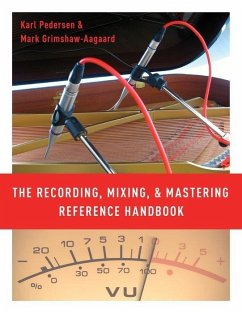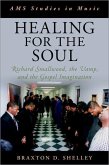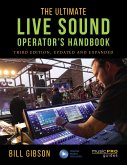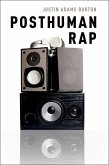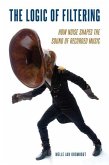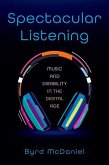Karl Pedersen (Lecturer in Recording & Lecturer i Audio Technology, Mark Grimshaw-Aagaard (Obel Professor of M Obel Professor of Music
The Recording, Mixing, and Mastering Reference Handbook
Karl Pedersen (Lecturer in Recording & Lecturer i Audio Technology, Mark Grimshaw-Aagaard (Obel Professor of M Obel Professor of Music
The Recording, Mixing, and Mastering Reference Handbook
- Broschiertes Buch
- Merkliste
- Auf die Merkliste
- Bewerten Bewerten
- Teilen
- Produkt teilen
- Produkterinnerung
- Produkterinnerung
The Recording, Mixing, and Mastering Reference Handbook provides an easy-to-read guide for music-making in the studio setting, from equipment fundamentals to recording and mixing almost any instrument.
Andere Kunden interessierten sich auch für
![Healing for the Soul Healing for the Soul]() Braxton D. Shelley (Assistant Professor, Department of Music, AssisHealing for the Soul87,99 €
Braxton D. Shelley (Assistant Professor, Department of Music, AssisHealing for the Soul87,99 €![The Voice of Virtue The Voice of Virtue]() Melinda Latour (Rumsey Family Assistant Professor in the HumanitiesThe Voice of Virtue107,99 €
Melinda Latour (Rumsey Family Assistant Professor in the HumanitiesThe Voice of Virtue107,99 €![The Ultimate Live Sound Operator's Handbook The Ultimate Live Sound Operator's Handbook]() Bill GibsonThe Ultimate Live Sound Operator's Handbook69,99 €
Bill GibsonThe Ultimate Live Sound Operator's Handbook69,99 €![Inside Computer Music Inside Computer Music]() Michael Clarke (Professor of Music, Professor of Music, UniversityInside Computer Music53,99 €
Michael Clarke (Professor of Music, Professor of Music, UniversityInside Computer Music53,99 €![Posthuman Rap Posthuman Rap]() Justin Adams Burton (Assistant Profes Assistant Professor of MusicPosthuman Rap49,99 €
Justin Adams Burton (Assistant Profes Assistant Professor of MusicPosthuman Rap49,99 €![Logic of Filtering P Logic of Filtering P]() Melle Jan Kromhout (Independent Scholar Independent Scholar)Logic of Filtering P43,99 €
Melle Jan Kromhout (Independent Scholar Independent Scholar)Logic of Filtering P43,99 €![Spectacular Listening Spectacular Listening]() Byrd McDaniel (Assistant Assistant Director of Student DevelopmentSpectacular Listening41,99 €
Byrd McDaniel (Assistant Assistant Director of Student DevelopmentSpectacular Listening41,99 €-
-
-
The Recording, Mixing, and Mastering Reference Handbook provides an easy-to-read guide for music-making in the studio setting, from equipment fundamentals to recording and mixing almost any instrument.
Hinweis: Dieser Artikel kann nur an eine deutsche Lieferadresse ausgeliefert werden.
Hinweis: Dieser Artikel kann nur an eine deutsche Lieferadresse ausgeliefert werden.
Produktdetails
- Produktdetails
- Verlag: Oxford University Press Inc
- Seitenzahl: 336
- Erscheinungstermin: 3. Januar 2019
- Englisch
- Abmessung: 279mm x 215mm x 22mm
- Gewicht: 832g
- ISBN-13: 9780190686642
- ISBN-10: 0190686642
- Artikelnr.: 52819654
- Herstellerkennzeichnung
- Libri GmbH
- Europaallee 1
- 36244 Bad Hersfeld
- gpsr@libri.de
- Verlag: Oxford University Press Inc
- Seitenzahl: 336
- Erscheinungstermin: 3. Januar 2019
- Englisch
- Abmessung: 279mm x 215mm x 22mm
- Gewicht: 832g
- ISBN-13: 9780190686642
- ISBN-10: 0190686642
- Artikelnr.: 52819654
- Herstellerkennzeichnung
- Libri GmbH
- Europaallee 1
- 36244 Bad Hersfeld
- gpsr@libri.de
Karl Pedersen owns and manages Blue Apple Lyd-design studios and Canta·Libris publishing house. In addition to having written several books on audio and sound, he also teaches music and sound technology and is a performing musician. Mark Grimshaw-Aagaard is Obel Professor of Music at Aalborg University, Denmark. He has published widely across subjects as diverse as sound, biofeedback in computer games, virtuality, the Uncanny Valley, and IT systems, and also writes free, open source software for virtual research environments (WIKINDX).
* About the Companion Website
* Introduction
* PART I The Instruments (practical recording and mix-techniques)
* Chapter 1 The Voice
* Acoustics and microphone settings · Vocal psychology · The Headphone
Mix · Tips · Various vocal techniques · The mix settings and effects
· Special uses of vocal microphones · Harmony vocals as overdub ·
Tips
* Chapter 2 The Drum Kit
* The Instrument and the acoustics · Mic setup · Mic technique: The
individual drums in the kit · Advanced mic setups · Mix-settings and
effects
* Chapter 3 The Bass Guitar
* The instrument · Mic or DI? · Or both? · Virtual amps · Mix-settings
and effects · Tips
* Chapter 4 The Electric Guitar
* The instrument · Mic techniques · Ambience and acoustics · Layering
guitars · Virtual stacks and re-amping · Mix-settings and effects ·
Tips
* Chapter 5 The Piano
* The Instrument and the acoustics · Always use condenser microphones ·
Recording acoustic pianos in the studio · Digital piano · Live
recording · Mix-settings and effects
* Chapter 6 The Acoustic Guitar
* The Instrument · Mic setup · Mix-settings and effects
* Chapter 7 The Recording of Some Less Common String Instruments
* The mandolin · The dobro · The banjo · The harp
* Chapter 8 Percussion
* Congas and bongos · Cajon · Claves · Djembe and bodhran · Tambourine
and shakers · Timbales · Xylophone, marimba, vibraphone, and
glockenspiel
* Chapter 9 The Double Bass and the 'Cello
* The Instrument and the acoustics · Mic setup · Stereo setups ·
Mix-settings and effects · Tips
* Chapter 10 The Violin and the Viola
* The Instrument and the acoustics · Mix-settings and Effects · Tips
* Chapter 11 Brass and Wind Instruments
* Brass and saxophones · The horn section · The flute · Tips
* Chapter 12 Synthesizers and Electronic Keyboards
* The instrument · DI, mics, or MIDI · Mix-settings and effects · Tips
* Chapter 13 The Leslie Speaker
* The Instrument · Mic setup · Mix-settings and effects
* Chapter 14 Live in the Studio
* Isolation booths and screens · Ghost Notes · Tips
* Chapter 15 Recording Choirs and Small Acoustic Ensembles
* The acoustics · Mic placement · Spot mics · Tips · Choirs with
accompaniment · Mix and editing
* PART II Microphone Techniques (principles/background theory)
* Chapter 16 Microphones: Types and Specifications
* The transducer types · Reading mic specifications · Comparing Mics
* Chapter 17 Microphones: Polar Pattern
* Cardioid · Omni · Figure-of-eight · Multi-pattern microphones ·
Shotgun microphones · Mic techniques · Omni v. cardioid: Choosing the
right polar pattern · Recording with omnis
* Chapter 18 Stereo Recording
* Spaced omni - The Decca tree - Baffled stereo · Coincident stereo ·
MS Stereo · More stereo setups: ORTF, NOS stereo, and binaural ·
* PART III Processors and Effects (principles and practice)
* Chapter 19 EQ and Instruments
* Sub bass (20-60 Hz) · Bass (60-250 Hz) · Low-mid (250 Hz to 2 kHz) ·
Midrange (2-4 kHz) · High-mid (4-6 kHz) · High (6-20 kHz) · The
components of the EQ · Common types of EQ · EQ'ing different
instruments - use your ears and your imagination · Complementary EQ
and contrasting frequency ranges · The graphic EQ · Tips
* Chapter 20 Harmonics and EQ
* The Harmonic Series · EQ'ing harmonics
* Chapter 21 Compressor/Limiter and Expander/Gate
* Compressor · Gate and Expander
* Chapter 22 History of the Reverb
* Natural ambience · Electronic reverbs · EMT 140 Plate Reverb · EMT
250 goes digital
* Chapter 23 Tape Echo and Digital Delay
* Tape echo · Digital delay · Calculating delay time · Using delays ·
Tips
* Chapter 24 Ambience and Reverb
* Digital reverbs in the studio · The parameters of the digital reverb
· Insert or send · Reverb-types · How to use reverb · Tips
* Chapter 25 Convolution Reverb
* Impulse response (IR) · IR libraries · Special FX · How to create an
IR · Tips for recording an IR
* Chapter 26 Modulation Effects
* Flanging · Chorus · Phase shift · The Haas Effect and doubling · Tips
* Chapter 27 Distortion and Tape Saturation
* Enhancing sounds with distortion · Tape saturation · Distortion used
as an effect · Tips
* Chapter 28 Varispeed and Pitch Processors
* Pitch shift · Pitch Correction · Manipulating sound with pitch
processors
* PART IV Mixing and Mastering (principles and practice)
* Chapter 29 The Mix
* The basic mix · Utilizing the stereo field · EQ · Depths and widths ·
The sound stage · Make the individual tracks on the mix sparkle - EQ
revisited · Stereo groups · Compression · Leave a little headroom to
the mastering engineer
* Chapter 30 Mastering
* The mastering studio · Mastering for CD · Mastering for online
streaming · The creative process · Mastering tools · Mid-side
processing · Bit resolution · Stem mastering
* PART V Acoustics (principles)
* Chapter 31 Phase and Comb Filtering
* The Comb Filter Effect · Multi-mic recording and phase · Critical
distances and frequencies · How to avoid phase cancellation
* Chapter 32 The Control Room and the Monitors
* The control room and the monitors · Principles for monitor placement
· The space and the monitors · Fine tuning the acoustics
* Chapter 33 The Recording Room
* Tuning the acoustics · The dimensions of the recording space ·
Separation · Diffusion · Tips
* PART VI Audio Standards, Plugs, and Connectors (principles)
* Chapter 34 Levels and Meters
* Levels · Audio levels in the signal chain and how they are measured ·
Meters · The dB(A) scale
* Chapter 35 Plugs and Connectors
* Plugs · Balanced connectors · Unbalanced audio · Tips · Inserts ·
Digital audio formats · Synchronizing digital · Word clock
* Introduction
* PART I The Instruments (practical recording and mix-techniques)
* Chapter 1 The Voice
* Acoustics and microphone settings · Vocal psychology · The Headphone
Mix · Tips · Various vocal techniques · The mix settings and effects
· Special uses of vocal microphones · Harmony vocals as overdub ·
Tips
* Chapter 2 The Drum Kit
* The Instrument and the acoustics · Mic setup · Mic technique: The
individual drums in the kit · Advanced mic setups · Mix-settings and
effects
* Chapter 3 The Bass Guitar
* The instrument · Mic or DI? · Or both? · Virtual amps · Mix-settings
and effects · Tips
* Chapter 4 The Electric Guitar
* The instrument · Mic techniques · Ambience and acoustics · Layering
guitars · Virtual stacks and re-amping · Mix-settings and effects ·
Tips
* Chapter 5 The Piano
* The Instrument and the acoustics · Always use condenser microphones ·
Recording acoustic pianos in the studio · Digital piano · Live
recording · Mix-settings and effects
* Chapter 6 The Acoustic Guitar
* The Instrument · Mic setup · Mix-settings and effects
* Chapter 7 The Recording of Some Less Common String Instruments
* The mandolin · The dobro · The banjo · The harp
* Chapter 8 Percussion
* Congas and bongos · Cajon · Claves · Djembe and bodhran · Tambourine
and shakers · Timbales · Xylophone, marimba, vibraphone, and
glockenspiel
* Chapter 9 The Double Bass and the 'Cello
* The Instrument and the acoustics · Mic setup · Stereo setups ·
Mix-settings and effects · Tips
* Chapter 10 The Violin and the Viola
* The Instrument and the acoustics · Mix-settings and Effects · Tips
* Chapter 11 Brass and Wind Instruments
* Brass and saxophones · The horn section · The flute · Tips
* Chapter 12 Synthesizers and Electronic Keyboards
* The instrument · DI, mics, or MIDI · Mix-settings and effects · Tips
* Chapter 13 The Leslie Speaker
* The Instrument · Mic setup · Mix-settings and effects
* Chapter 14 Live in the Studio
* Isolation booths and screens · Ghost Notes · Tips
* Chapter 15 Recording Choirs and Small Acoustic Ensembles
* The acoustics · Mic placement · Spot mics · Tips · Choirs with
accompaniment · Mix and editing
* PART II Microphone Techniques (principles/background theory)
* Chapter 16 Microphones: Types and Specifications
* The transducer types · Reading mic specifications · Comparing Mics
* Chapter 17 Microphones: Polar Pattern
* Cardioid · Omni · Figure-of-eight · Multi-pattern microphones ·
Shotgun microphones · Mic techniques · Omni v. cardioid: Choosing the
right polar pattern · Recording with omnis
* Chapter 18 Stereo Recording
* Spaced omni - The Decca tree - Baffled stereo · Coincident stereo ·
MS Stereo · More stereo setups: ORTF, NOS stereo, and binaural ·
* PART III Processors and Effects (principles and practice)
* Chapter 19 EQ and Instruments
* Sub bass (20-60 Hz) · Bass (60-250 Hz) · Low-mid (250 Hz to 2 kHz) ·
Midrange (2-4 kHz) · High-mid (4-6 kHz) · High (6-20 kHz) · The
components of the EQ · Common types of EQ · EQ'ing different
instruments - use your ears and your imagination · Complementary EQ
and contrasting frequency ranges · The graphic EQ · Tips
* Chapter 20 Harmonics and EQ
* The Harmonic Series · EQ'ing harmonics
* Chapter 21 Compressor/Limiter and Expander/Gate
* Compressor · Gate and Expander
* Chapter 22 History of the Reverb
* Natural ambience · Electronic reverbs · EMT 140 Plate Reverb · EMT
250 goes digital
* Chapter 23 Tape Echo and Digital Delay
* Tape echo · Digital delay · Calculating delay time · Using delays ·
Tips
* Chapter 24 Ambience and Reverb
* Digital reverbs in the studio · The parameters of the digital reverb
· Insert or send · Reverb-types · How to use reverb · Tips
* Chapter 25 Convolution Reverb
* Impulse response (IR) · IR libraries · Special FX · How to create an
IR · Tips for recording an IR
* Chapter 26 Modulation Effects
* Flanging · Chorus · Phase shift · The Haas Effect and doubling · Tips
* Chapter 27 Distortion and Tape Saturation
* Enhancing sounds with distortion · Tape saturation · Distortion used
as an effect · Tips
* Chapter 28 Varispeed and Pitch Processors
* Pitch shift · Pitch Correction · Manipulating sound with pitch
processors
* PART IV Mixing and Mastering (principles and practice)
* Chapter 29 The Mix
* The basic mix · Utilizing the stereo field · EQ · Depths and widths ·
The sound stage · Make the individual tracks on the mix sparkle - EQ
revisited · Stereo groups · Compression · Leave a little headroom to
the mastering engineer
* Chapter 30 Mastering
* The mastering studio · Mastering for CD · Mastering for online
streaming · The creative process · Mastering tools · Mid-side
processing · Bit resolution · Stem mastering
* PART V Acoustics (principles)
* Chapter 31 Phase and Comb Filtering
* The Comb Filter Effect · Multi-mic recording and phase · Critical
distances and frequencies · How to avoid phase cancellation
* Chapter 32 The Control Room and the Monitors
* The control room and the monitors · Principles for monitor placement
· The space and the monitors · Fine tuning the acoustics
* Chapter 33 The Recording Room
* Tuning the acoustics · The dimensions of the recording space ·
Separation · Diffusion · Tips
* PART VI Audio Standards, Plugs, and Connectors (principles)
* Chapter 34 Levels and Meters
* Levels · Audio levels in the signal chain and how they are measured ·
Meters · The dB(A) scale
* Chapter 35 Plugs and Connectors
* Plugs · Balanced connectors · Unbalanced audio · Tips · Inserts ·
Digital audio formats · Synchronizing digital · Word clock
* About the Companion Website
* Introduction
* PART I The Instruments (practical recording and mix-techniques)
* Chapter 1 The Voice
* Acoustics and microphone settings · Vocal psychology · The Headphone
Mix · Tips · Various vocal techniques · The mix settings and effects
· Special uses of vocal microphones · Harmony vocals as overdub ·
Tips
* Chapter 2 The Drum Kit
* The Instrument and the acoustics · Mic setup · Mic technique: The
individual drums in the kit · Advanced mic setups · Mix-settings and
effects
* Chapter 3 The Bass Guitar
* The instrument · Mic or DI? · Or both? · Virtual amps · Mix-settings
and effects · Tips
* Chapter 4 The Electric Guitar
* The instrument · Mic techniques · Ambience and acoustics · Layering
guitars · Virtual stacks and re-amping · Mix-settings and effects ·
Tips
* Chapter 5 The Piano
* The Instrument and the acoustics · Always use condenser microphones ·
Recording acoustic pianos in the studio · Digital piano · Live
recording · Mix-settings and effects
* Chapter 6 The Acoustic Guitar
* The Instrument · Mic setup · Mix-settings and effects
* Chapter 7 The Recording of Some Less Common String Instruments
* The mandolin · The dobro · The banjo · The harp
* Chapter 8 Percussion
* Congas and bongos · Cajon · Claves · Djembe and bodhran · Tambourine
and shakers · Timbales · Xylophone, marimba, vibraphone, and
glockenspiel
* Chapter 9 The Double Bass and the 'Cello
* The Instrument and the acoustics · Mic setup · Stereo setups ·
Mix-settings and effects · Tips
* Chapter 10 The Violin and the Viola
* The Instrument and the acoustics · Mix-settings and Effects · Tips
* Chapter 11 Brass and Wind Instruments
* Brass and saxophones · The horn section · The flute · Tips
* Chapter 12 Synthesizers and Electronic Keyboards
* The instrument · DI, mics, or MIDI · Mix-settings and effects · Tips
* Chapter 13 The Leslie Speaker
* The Instrument · Mic setup · Mix-settings and effects
* Chapter 14 Live in the Studio
* Isolation booths and screens · Ghost Notes · Tips
* Chapter 15 Recording Choirs and Small Acoustic Ensembles
* The acoustics · Mic placement · Spot mics · Tips · Choirs with
accompaniment · Mix and editing
* PART II Microphone Techniques (principles/background theory)
* Chapter 16 Microphones: Types and Specifications
* The transducer types · Reading mic specifications · Comparing Mics
* Chapter 17 Microphones: Polar Pattern
* Cardioid · Omni · Figure-of-eight · Multi-pattern microphones ·
Shotgun microphones · Mic techniques · Omni v. cardioid: Choosing the
right polar pattern · Recording with omnis
* Chapter 18 Stereo Recording
* Spaced omni - The Decca tree - Baffled stereo · Coincident stereo ·
MS Stereo · More stereo setups: ORTF, NOS stereo, and binaural ·
* PART III Processors and Effects (principles and practice)
* Chapter 19 EQ and Instruments
* Sub bass (20-60 Hz) · Bass (60-250 Hz) · Low-mid (250 Hz to 2 kHz) ·
Midrange (2-4 kHz) · High-mid (4-6 kHz) · High (6-20 kHz) · The
components of the EQ · Common types of EQ · EQ'ing different
instruments - use your ears and your imagination · Complementary EQ
and contrasting frequency ranges · The graphic EQ · Tips
* Chapter 20 Harmonics and EQ
* The Harmonic Series · EQ'ing harmonics
* Chapter 21 Compressor/Limiter and Expander/Gate
* Compressor · Gate and Expander
* Chapter 22 History of the Reverb
* Natural ambience · Electronic reverbs · EMT 140 Plate Reverb · EMT
250 goes digital
* Chapter 23 Tape Echo and Digital Delay
* Tape echo · Digital delay · Calculating delay time · Using delays ·
Tips
* Chapter 24 Ambience and Reverb
* Digital reverbs in the studio · The parameters of the digital reverb
· Insert or send · Reverb-types · How to use reverb · Tips
* Chapter 25 Convolution Reverb
* Impulse response (IR) · IR libraries · Special FX · How to create an
IR · Tips for recording an IR
* Chapter 26 Modulation Effects
* Flanging · Chorus · Phase shift · The Haas Effect and doubling · Tips
* Chapter 27 Distortion and Tape Saturation
* Enhancing sounds with distortion · Tape saturation · Distortion used
as an effect · Tips
* Chapter 28 Varispeed and Pitch Processors
* Pitch shift · Pitch Correction · Manipulating sound with pitch
processors
* PART IV Mixing and Mastering (principles and practice)
* Chapter 29 The Mix
* The basic mix · Utilizing the stereo field · EQ · Depths and widths ·
The sound stage · Make the individual tracks on the mix sparkle - EQ
revisited · Stereo groups · Compression · Leave a little headroom to
the mastering engineer
* Chapter 30 Mastering
* The mastering studio · Mastering for CD · Mastering for online
streaming · The creative process · Mastering tools · Mid-side
processing · Bit resolution · Stem mastering
* PART V Acoustics (principles)
* Chapter 31 Phase and Comb Filtering
* The Comb Filter Effect · Multi-mic recording and phase · Critical
distances and frequencies · How to avoid phase cancellation
* Chapter 32 The Control Room and the Monitors
* The control room and the monitors · Principles for monitor placement
· The space and the monitors · Fine tuning the acoustics
* Chapter 33 The Recording Room
* Tuning the acoustics · The dimensions of the recording space ·
Separation · Diffusion · Tips
* PART VI Audio Standards, Plugs, and Connectors (principles)
* Chapter 34 Levels and Meters
* Levels · Audio levels in the signal chain and how they are measured ·
Meters · The dB(A) scale
* Chapter 35 Plugs and Connectors
* Plugs · Balanced connectors · Unbalanced audio · Tips · Inserts ·
Digital audio formats · Synchronizing digital · Word clock
* Introduction
* PART I The Instruments (practical recording and mix-techniques)
* Chapter 1 The Voice
* Acoustics and microphone settings · Vocal psychology · The Headphone
Mix · Tips · Various vocal techniques · The mix settings and effects
· Special uses of vocal microphones · Harmony vocals as overdub ·
Tips
* Chapter 2 The Drum Kit
* The Instrument and the acoustics · Mic setup · Mic technique: The
individual drums in the kit · Advanced mic setups · Mix-settings and
effects
* Chapter 3 The Bass Guitar
* The instrument · Mic or DI? · Or both? · Virtual amps · Mix-settings
and effects · Tips
* Chapter 4 The Electric Guitar
* The instrument · Mic techniques · Ambience and acoustics · Layering
guitars · Virtual stacks and re-amping · Mix-settings and effects ·
Tips
* Chapter 5 The Piano
* The Instrument and the acoustics · Always use condenser microphones ·
Recording acoustic pianos in the studio · Digital piano · Live
recording · Mix-settings and effects
* Chapter 6 The Acoustic Guitar
* The Instrument · Mic setup · Mix-settings and effects
* Chapter 7 The Recording of Some Less Common String Instruments
* The mandolin · The dobro · The banjo · The harp
* Chapter 8 Percussion
* Congas and bongos · Cajon · Claves · Djembe and bodhran · Tambourine
and shakers · Timbales · Xylophone, marimba, vibraphone, and
glockenspiel
* Chapter 9 The Double Bass and the 'Cello
* The Instrument and the acoustics · Mic setup · Stereo setups ·
Mix-settings and effects · Tips
* Chapter 10 The Violin and the Viola
* The Instrument and the acoustics · Mix-settings and Effects · Tips
* Chapter 11 Brass and Wind Instruments
* Brass and saxophones · The horn section · The flute · Tips
* Chapter 12 Synthesizers and Electronic Keyboards
* The instrument · DI, mics, or MIDI · Mix-settings and effects · Tips
* Chapter 13 The Leslie Speaker
* The Instrument · Mic setup · Mix-settings and effects
* Chapter 14 Live in the Studio
* Isolation booths and screens · Ghost Notes · Tips
* Chapter 15 Recording Choirs and Small Acoustic Ensembles
* The acoustics · Mic placement · Spot mics · Tips · Choirs with
accompaniment · Mix and editing
* PART II Microphone Techniques (principles/background theory)
* Chapter 16 Microphones: Types and Specifications
* The transducer types · Reading mic specifications · Comparing Mics
* Chapter 17 Microphones: Polar Pattern
* Cardioid · Omni · Figure-of-eight · Multi-pattern microphones ·
Shotgun microphones · Mic techniques · Omni v. cardioid: Choosing the
right polar pattern · Recording with omnis
* Chapter 18 Stereo Recording
* Spaced omni - The Decca tree - Baffled stereo · Coincident stereo ·
MS Stereo · More stereo setups: ORTF, NOS stereo, and binaural ·
* PART III Processors and Effects (principles and practice)
* Chapter 19 EQ and Instruments
* Sub bass (20-60 Hz) · Bass (60-250 Hz) · Low-mid (250 Hz to 2 kHz) ·
Midrange (2-4 kHz) · High-mid (4-6 kHz) · High (6-20 kHz) · The
components of the EQ · Common types of EQ · EQ'ing different
instruments - use your ears and your imagination · Complementary EQ
and contrasting frequency ranges · The graphic EQ · Tips
* Chapter 20 Harmonics and EQ
* The Harmonic Series · EQ'ing harmonics
* Chapter 21 Compressor/Limiter and Expander/Gate
* Compressor · Gate and Expander
* Chapter 22 History of the Reverb
* Natural ambience · Electronic reverbs · EMT 140 Plate Reverb · EMT
250 goes digital
* Chapter 23 Tape Echo and Digital Delay
* Tape echo · Digital delay · Calculating delay time · Using delays ·
Tips
* Chapter 24 Ambience and Reverb
* Digital reverbs in the studio · The parameters of the digital reverb
· Insert or send · Reverb-types · How to use reverb · Tips
* Chapter 25 Convolution Reverb
* Impulse response (IR) · IR libraries · Special FX · How to create an
IR · Tips for recording an IR
* Chapter 26 Modulation Effects
* Flanging · Chorus · Phase shift · The Haas Effect and doubling · Tips
* Chapter 27 Distortion and Tape Saturation
* Enhancing sounds with distortion · Tape saturation · Distortion used
as an effect · Tips
* Chapter 28 Varispeed and Pitch Processors
* Pitch shift · Pitch Correction · Manipulating sound with pitch
processors
* PART IV Mixing and Mastering (principles and practice)
* Chapter 29 The Mix
* The basic mix · Utilizing the stereo field · EQ · Depths and widths ·
The sound stage · Make the individual tracks on the mix sparkle - EQ
revisited · Stereo groups · Compression · Leave a little headroom to
the mastering engineer
* Chapter 30 Mastering
* The mastering studio · Mastering for CD · Mastering for online
streaming · The creative process · Mastering tools · Mid-side
processing · Bit resolution · Stem mastering
* PART V Acoustics (principles)
* Chapter 31 Phase and Comb Filtering
* The Comb Filter Effect · Multi-mic recording and phase · Critical
distances and frequencies · How to avoid phase cancellation
* Chapter 32 The Control Room and the Monitors
* The control room and the monitors · Principles for monitor placement
· The space and the monitors · Fine tuning the acoustics
* Chapter 33 The Recording Room
* Tuning the acoustics · The dimensions of the recording space ·
Separation · Diffusion · Tips
* PART VI Audio Standards, Plugs, and Connectors (principles)
* Chapter 34 Levels and Meters
* Levels · Audio levels in the signal chain and how they are measured ·
Meters · The dB(A) scale
* Chapter 35 Plugs and Connectors
* Plugs · Balanced connectors · Unbalanced audio · Tips · Inserts ·
Digital audio formats · Synchronizing digital · Word clock

